ASUS K53E: Testing Dual-Core Sandy Bridge
by Jarred Walton on April 8, 2011 1:00 AM EST- Posted in
- Laptops
- Intel
- Sandy Bridge
- Asus
General Performance – Dual-Core Sandy Bridge vs. the World
So now we get to the numbers, and this is where some of the competing solutions will really take a beating. Let’s just cut straight to the chase and look at the graphs. We’ve highlighted the K53E in our standard bright green, with the ASUS U41JF in black, Apple's dual-core i5-2415M MBP13 in gold, and the quad-core i7-2820QM in yellow.
One interesting piece of information prior to the benchmark discussion is that despite having a theoretical maximum Turbo speed of 3.2GHz, we rarely see the i5-2520M hit that mark in testing. Using CPUID’s TMonitor utility, in the single-core Cinebench result we see both cores fluctuate between 800 to 3100MHz. It appears the Windows task scheduler isn’t quite sure how to best distribute the load, which is a common problem. However, in the multi-threaded Cinebench test the two CPU cores run at a constant 2.9GHz, as expected.

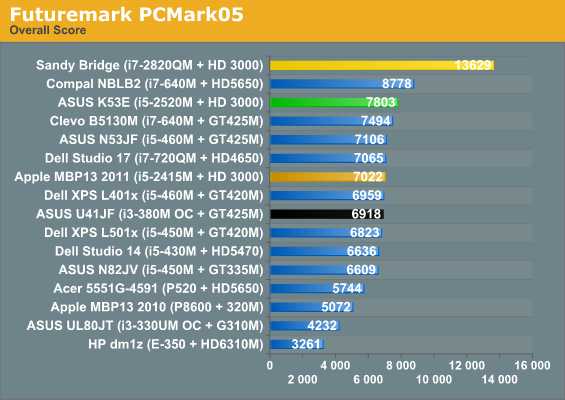
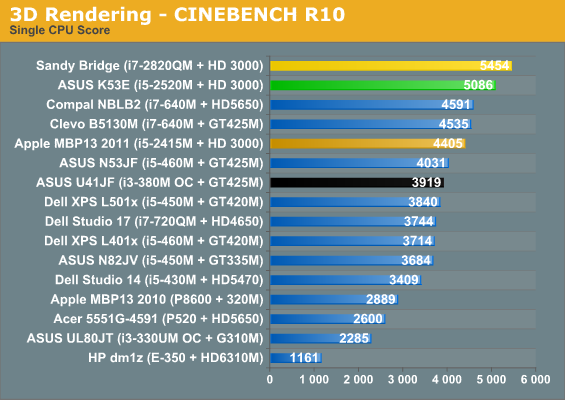
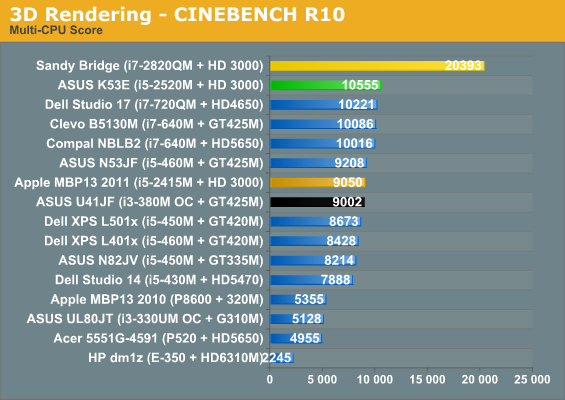
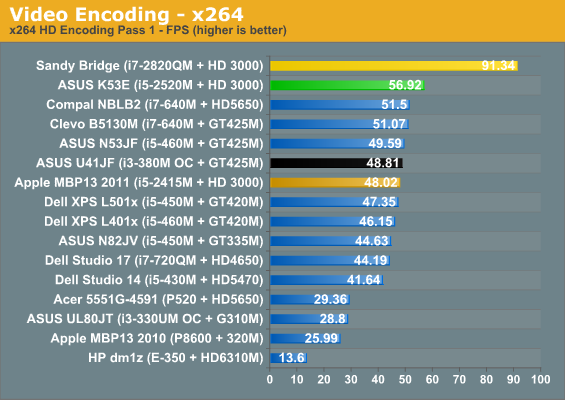

Starting with the new MBP13 comparison, the K53E with i5-2520M comes out an average of 20% faster. Some of that can be attributed to the hard drive differences, as PCMark Vantage shows Apple’s HDD choice is particularly poor, but the CPU intensive tasks are also 15 to 25% faster. It’s interesting that ASUS’ UL41JF happens to put in an overall showing in these applications that matches the MBP13, but that’s in a large part thanks to the 15% overclock. Looking at stock Arrandale CPUs, the i5-2520M turns in slightly higher performance results than the i7-640M, the highest-clocked Arrandale CPU we’ve tested. Even the old i7-720QM in the Dell Studio 17 fails to match the performance of the i5-2520M, which leads by an average of 18% in the above benchmarks (with the only loss coming in Pass 2 of x264 encoding).
Move up to quad-core SNB and an SSD, and of course the dual-core parts look a lot weaker. The i7-2820QM average lead in the above charts is 74%, but part of that is the thanks to the 104% lead in PCMark Vantage. Remove the PCMark results, though, and the 2820QM is still 65% faster than the 2520M. On the other side of the charts—literally—is AMD’s E-350. We know it’s not meant to compete with Sandy Bridge (or even Arrandale or Core 2 Duo), but keep in mind that the cheapest price for such a laptop is going to be around $450. On average, the i5-2520M lays the smack down hard and ends up roughly four times faster than an E-350. Ah, but the E-350 has a much better IGP, right? Well, maybe it’s better, but it’s certainly not faster than Intel’s HD 3000 when it’s bottlenecked by the CPU; here are some 3DMark results before we get to the games to give you an idea of how graphics performance compares.
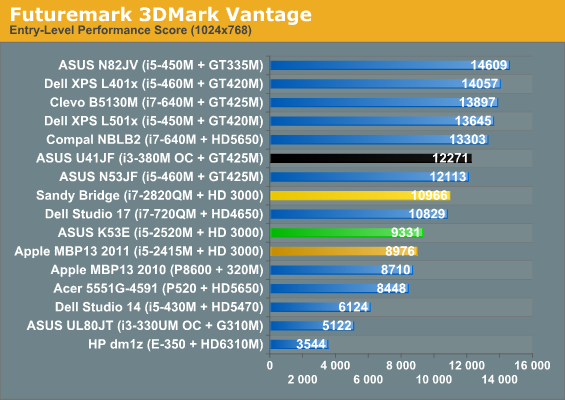
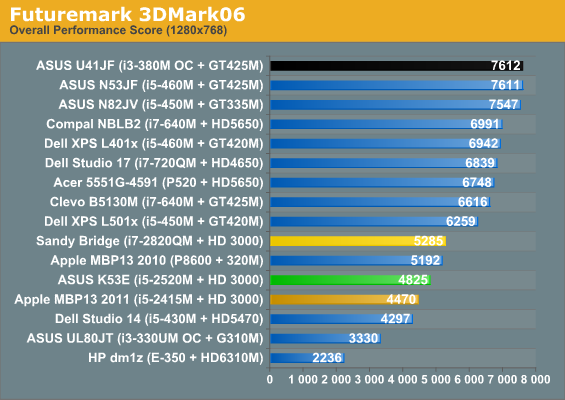
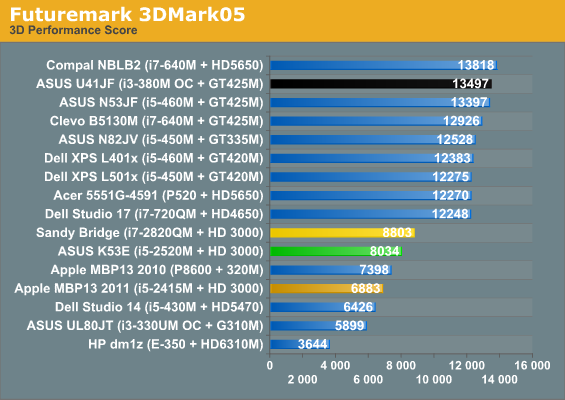
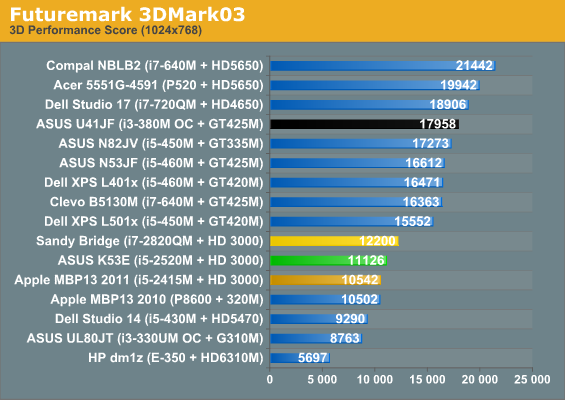
While we would never take 3DMark as the end-all, be-all of graphics performance comparisons, it does give a general idea of what we can expect. The K53E with i5-2520M turns in performance that’s 9% faster than the MBP13 on average across the four versions of 3DMark. That’s actually pretty accurate, as we’ll see in the gaming tests. Likewise, the i7-2820QM results end up being 12% faster than the 2520M, possibly from more aggressive IGP Turbo modes. Again, that matches what we’ll see in the games. On the other hand, even a middling dGPU like the GT 420M/425M still comes out 40-50% ahead of the HD 3000, and AMD’s HD 5650 is 60% faster on average.
What about AMD’s Fusion E-350 platform? If the 3DMark results hold in our actual gaming tests, Intel’s “horrible” HD 3000 IGP offers over twice the performance of the HD 6310M. In fact, even an Arrandale IGP would come within 10% of the E-350 results in 3DMark. It’s not that we love Intel or want them to pummel AMD, and we understand that the E-350 competes in a lower price bracket. Still, many people like to get carried away in discussions of how much better AMD’s graphics are compared to Intel’s IGP. That’s certainly true when you’re looking at discrete GPUs, and compatibility is still better with AMD and NVIDIA drivers, but the latest SNB IGP changed the status quo. HD 3000 works in about 90% of games (roughly estimating), performs well enough to be playable in about 80% of titles, posts scores that are competitive with HD 5470 and GT 320M (and often twice what the current Brazos can achieve), and you get it for free with any 2nd Gen Core i-series CPU. As a friend of mine is fond of saying, it’s hard to compete with “free”.










78 Comments
View All Comments
DanNeely - Monday, April 11, 2011 - link
Llano's IGP have the potential to be moderately faster than the current entry level mobile IGPs. On paper it's the equivalent to a 6630-6730M. Having to share the DDR3 memory with the CPU will probably hold it back somewhat, but it very much has the potential to a viable part for light gaming systems.mino - Tuesday, April 12, 2011 - link
"to be moderately faster than the current entry level mobile IGPs"Is that a joke or what ?
Llano has the potential to challenge the mid-range mobile GPU market with even its cheapest version running circles around any other IGP/APU around.
kevlno3 - Saturday, July 30, 2011 - link
Pls dont comments when you not read review. Mino , i 100% support you. Llano is the IGP is same speed as HD5650 ,HD6550 or even HD6630. it's not HD5470 or even HD3000 can be compare.it's totally complete solution for value of money best buy. but Intel keep creat the high benchmark score to blur the consumer . try to make people feel regret if you pay such money to buy the low end Llano. in fact , i was totally disappointed with Intel. Core i3 2310 can't perform well. i even felt lag when i play in war craft 3 frozen throne in battlenet during 3 vs 3. i can't find my pointer. it's normally lag will make u have this problem.
biostud - Friday, April 8, 2011 - link
both s and b models :)jonup - Friday, April 8, 2011 - link
Just from curiosity, does dropping from dual channel to single channel have any significant effect on the performance of the modern laptops/desktops? Many manufactures have been shipping their laptops with odd RAM capacities 3GB/6GB, which has been a turnoff for me, but it appears to be a good marketing gimmick for those who have no clue.Thank for the nice laptop reviews you guys put out there!
IntelUser2000 - Friday, April 8, 2011 - link
The manufacturers I think bundle the smaller capacity DIMM for free so sell that and get a matching stick from NCIX or something.The way the asynchronous dual channel(Intel Flex Memory) works is only half of the greater capacity DIMM is transferring data simultaneously with the smaller DIMM.
So:
4GB + 2GB
4GB stick: 2GB Dual channel + 2GB Single channel
2GB stick: This is doubled up with half of the 4GB stick
So in theory your max bandwidth is like 1.5 channels. Measured bandwidth is between single and dual channel too, but the complexity of splitting the greater capacity puts performance closer to a single channel in some applications.
mino - Tuesday, April 12, 2011 - link
It does not work that way. In any mixed config the IMC falls back to a single-channel-like operating mode.JarredWalton - Tuesday, April 12, 2011 - link
It would be nice if you at least tried to do some research before making completely false statements. Flex memory works exactly as IU2k describes, with basic details here:http://www.intel.com/support/motherboards/desktop/...
Pretty much every Intel CPU/chipset since the P45/X38 has supported flex memory. All you have to do is check ARK:
http://ark.intel.com/Product.aspx?id=52229&cod...
Quote: "Intel Flex Memory Technology -- Facilitates easier upgrades by allowing different memory sizes to be populated and remain in dual-channel mode." Don't confuse limitations of older chipsets and AMD's (older) IMC with current implementations.
silverblue - Friday, April 8, 2011 - link
...that Brazos isn't clocked higher nor operates on a dual channel memory bus. It would be amusing to expect a 500MHz GPU sporting a bandwidth limitation with a mobile part which is 650MHz and, with Turbo, 1.3GHz, and utilises a dual-channel bus, and that's well before we factor CPU performance into things.For what it does, Brazos is excellent, but people really shouldn't think of it as competition for Sandy Bridge. It's really not meant to be anywhere near close to it in terms of performance or price, and it's a shame that some manufacturers seem to have forgotten that. Unfortunately, as said before, Brazos machines may encroach on CULV territory...
IntelUser2000 - Friday, April 8, 2011 - link
An error and few points I'd like to make:"Even the U41JF can’t match the K53E for efficiency, despite underclocking the i3-380M to 700-900MHz (instead of the normal 933-1200MHz) and having a smaller 14” LCD."
i3-380M is a 2.53GHz part. Why are you testing an underclocked version on the battery life test again?
"What really impresses me is that you can get similar battery life (in light workloads) with either the dual-core or quad-core SND parts,"
Huh. Equalizing to battery capacity:
DC(QC) min/WHr
Idle: 7.66(6.63) +15.5%
Internet: 6.43(5.86) +9.7%
H.264 playback: 4.77(3.66) +30.3%
10-15% increase in battery life is not identical. Also, the screen on the QC system is larger, but sports a more efficient SSD drive. If the Hurry up and Get Idle works well, it would be better on the QC thanks to the SSD.
"Ah, but the E-350 has a much better IGP, right?"
I'm not sure whether that's a question or a statement. While the E-350 has a HD5450/5470 core, its severely bottlenecked by memory subsystem, in addition to having it share with the GPU, before the CPU differences.
"The result is better battery life, but compared to Arrandale it’s not a huge change in two of our tests."
SNB DC(ARND)
Idle: 7.66(6.64) +15.3%
Internet: 6.43(5.29) +21.6%
H.264 playback: 4.77(3.07) +55.3%
While Idle and Internet battery life isn't big as H.264, 15-20% battery isn't something minor. In fact, if you look back to Core 2 vs Core Duo and Penryn vs Merom comparisons, the battery gains are equal to 2x for the ones back then.
Overall I think the DC Sandy Bridge is being underrated on the review. The asynchronous RAM is a bit of a sore to look at too. Last benchmark I put the bandwidth figure at somewhere between single and dual channel, and Intel documents indicate increased latency when transferring between sticks.